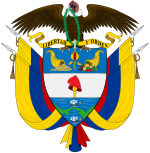
| History of Colombia | ||||||||||||||||||||
|---|---|---|---|---|---|---|---|---|---|---|---|---|---|---|---|---|---|---|---|---|
 | ||||||||||||||||||||
| Timeline | ||||||||||||||||||||
|
||||||||||||||||||||
|
| ||||||||||||||||||||
The separation of Panama from Colombia was formalized on 3 November 1903, with the establishment of the Republic of Panama and the abolishment of the Colombia-Costa Rica border. From the Independence of Panama from Spain in 1821, Panama had simultaneously declared independence from Spain and joined itself to the confederation of Gran Colombia through the Independence Act of Panama. Panama was always tenuously connected to the rest of the country to the south, owing to its remoteness from the government in Bogotá and lack of a practical overland connection to the rest of Gran Colombia. In 1840–41, a short-lived independent republic was established under Tomás de Herrera. After rejoining Colombia following a 13-month independence, it remained a province which saw frequent rebellious flare-ups, notably the Panama crisis of 1885, which saw the intervention of the United States Navy, and a reaction by the Chilean Navy.
During the construction of the Panama Canal, the initial attempts by France to construct a sea-level canal across the isthmus were secured through treaty with Colombia; however French cost overruns and corruption in the Panama scandals led to abandonment of the canal for a decade. During the intervening years, local separatists used the political instability of the Thousand Days' War to agitate for political separation from Colombia and establishment of an independent republic. When the United States sought to take over the canal project, the government of Colombia proved difficult to work with, and with the cooperation of French financier Philippe-Jean Bunau-Varilla, Panama simultaneously declared independence from Colombia and negotiated a treaty granting the U.S. the right to construct the canal.
The United States was the first country to recognize the independence of the nascent republic, sending the U.S. Navy to prevent Colombia from retaking the territory during the early days of the new Republic. In exchange for its role in defending the Republic, and for constructing the canal, the U.S. was granted a perpetual lease on the land around the canal, known as the Panama Canal Zone, which was returned to Panama in 1999 under the terms of the Torrijos–Carter Treaties.
After the United States, many other nations quickly recognized the independent republic, though Colombia refused to do so until 1909, after receiving a $500,000 concession from Panama to cover its share of the debts it owed at independence.